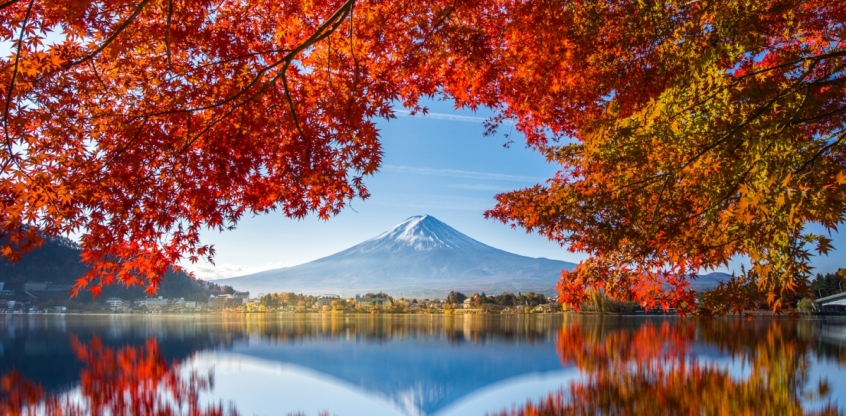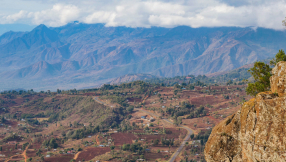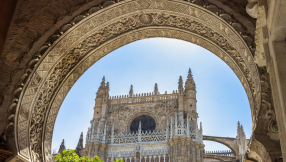
The writer of the Letter to the Hebrews reminds Christians that they are surrounded by a great "cloud of witnesses." (NRSV) That "cloud" has continued to grow in size since then. In this monthly column we will be thinking about some of the people and events, over the past 2000 years, that have helped make up this "cloud." People and events that have helped build the community of the Christian church as it exists today.
In 2022, Christianity is one of the minority religions of Japan. It has been estimated that only about 1% of the modern Japanese population is Christian. Of these, 60% are Protestants and 40% Catholics. The majority of Japanese people who identify with a religious belief either follow the traditional Shinto faith or are Buddhists.
However, despite constituting a tiny minority of the current Japanese population, Christianity has an impact on Japanese culture out of proportion to the size of the active faith community.
Christian faith is growing among young people and, intriguingly, about 60% of Japanese weddings take place within a Christian context. An investigation of the phenomenon in 2015, in the "Japanese Journal of Religious Studies", found that Christian wedding ceremonies had replaced Shinto ones as "Japan's wedding ceremony of choice".
This is particularly intriguing since the vast majority of Japanese claim to be mushukyo (non-religious). This seems to indicate a modern relationship with Christianity which is more geared to accessing an institution, and its professionals – viewed as a repository of tradition and spirituality – than committing to a personal faith.
These ceremonies are often described as a curious blend of secular fashion, conspicuous consumption, and religious behaviour – among couples who generally assert no religious faith of any kind. Nevertheless, it still indicates a positive view of the faith and its practices and a desire to be associated with it, even if in a very limited way. It is one of the more surprising aspects of the role of Christianity within Japanese society.
What is more surprising is that the historic roots of Christianity in Japan go back over four hundred years, to a period of enthusiastic growth, followed by brutal persecution, that is far removed from ideas of Christian rituals as modern fashion statements.
The first Japanese Christians
There is a possibility that some medieval Christian missionaries first reached Japan in the 13<sup>th century. What is certain is that Portuguese-sponsored Catholics first reached Japan in 1549. The most famous of these missionaries was Francis Xavier (1506-52), who arrived in Japan with three Japanese Catholic converts from Malacca and Goa, and other Jesuits.
The first named Japanese Christian convert (who arrived with this group) was Anjiro or Yajiro. Xavier's missionary work, which occurred between 1549 and 1551, laid the foundation for the future Christian church in Japan. The first church building was constructed in Kyoto in 1576.
Roman Catholic missionary activity in the Japanese islands was initially led by Jesuits, such as Xavier; and later, in the 1590s, by monastic orders such as the Franciscans and Dominicans, who were Spanish.
The new faith soon gained many followers. While exact numbers are hard to calculate, it has been estimated that by 1615 the Christian church in Japan numbered in the region of 500,000 believers or 4% of a national population of 12 million. This was a significant community. The city of Nagasaki became the organising hub of early Japanese Catholicism and the community, which was organised from there, kept close cultural and religious ties to its Portuguese origins.
However, the close connection between the Japanese church and colonial powers left it open to charges of being a foreign ideology and opening the door to Western colonialism. This, of course, was not limited to Japan, since colonial expansion and the spread of the Christian faith were closely connected throughout the period of Western imperialism.
The main difference between Japan and many other areas (in Asia, Africa, and the Americas) was that Japan did not become part of any European empire. And those who held power in Japan were determined to keep it this way. These influential actors in the power politics of Japan increasingly saw Christians as foreign agents. In the 17<sup>th century this led to a reaction which included terrible violence.
Repression and persecution
Those who have seen the harrowing film "Silence" (2016) – starring Andrew Garfield, Adam Driver, Liam Neeson, Tadanobu Asano, and Ciarán Hinds, will have some idea of what happened next to those who had accepted Christianity. Among the many distressing scenes in the film, the one that lingers with me is that of the Christians tied to crosses and left to drown in the waters of the incoming tide. What led to this?
Growing antagonism to Christianity accompanied a time of social unrest when Christians were blamed for peasant resistance to the demands of their feudal overlords. As a result, the de facto ruler Shogun Hideyoshi issued the first decree banning the spreading of the Christian faith in 1587. Shinto and Buddhism were to be the only religions of Japan.
It was clearly an attempt to reinforce traditional Japanese culture and stop the spread of a belief which had Western connections. This opposition to the faith was assisted by divisions among those organising the missions, due to rivalry between the Spanish and the Portuguese. However, this action by Shogun Hideyoshi did not lead to systematic persecution. But this was soon to occur.
The first victims of the increasing suspicion against the new religion were six Franciscan friars and twenty of their Japanese converts. They were executed at Nagasaki in 1597. Tied to crosses, they were speared to death. These were the first of the Japanese Martyrs.
According to tradition, one of those martyred for their faith was a 12-year-old boy. A nobleman called on him to renounce his faith. Instead, he asked which was his cross, and was directed to one smaller than the others. He embraced it. Then he died on it. The Jesuits arrested were released due to their connections with the Japanese court.
The year before this, in 1596, the pilot of a Spanish ship which had run aground told his interrogators that the Spanish preceded colonial conquest with missionary activity. This only fuelled the suspicions of the Japanese rulers. The martyrdom of the 26 was a taste of things to come.
What became an intense persecution of Japanese Christians and foreign missionaries coincided with the rise of what is called the "Tokugawa shogunate" (1603-1867). This was a period when – following a series of civil wars – an elite family of "shoguns", called the Tokugawa (and their samurai warrior supporters), became the latest in a line of non-imperial families to gain an ascendancy which overshadowed the Japanese emperor (a figure possessing symbolic authority but little actual power). During the period of the Tokugawa shogunate, Japan gradually closed its borders to foreign influence.
In 1614 an edict of persecution was announced. Christians were arrested, imprisoned for life, or tortured and killed; churches were destroyed; by 1630, the church was totally driven underground. Those who refused to renounce their faith, but continued it in secret, became known as "Kakure Kirishitan" ("hidden Christians").
In 1637-38 a peasant uprising, called the "Shimabara Rebellion", took place in Kyushu under Christian leadership. It was an attempt to resist the persecution. The rebellion was put down and the government formally closed the country to Roman Catholic traders as well as to Christian missionaries. This was a policy known as "sakoku" (literally "locked country"). The Protestant Dutch were the only Europeans who were allowed limited trading rights, because they eschewed missionary activity. For them trade trumped faith.
To detect Christians, the ruling authorities created "fumi-e" (literally "stepping-on pictures"). Each had on it a likeness of Jesus or the Virgin Mary on which those suspected of being Christians were ordered to stand. The act of disrespect was taken as either evidence of the absence of Christian faith, or repudiation of it. The test was performed annually.
The use of "fumi-e" was not officially abandoned until Japanese ports were finally opened to foreigners in 1856, as a result of US naval power which had forced an entry into Japan in 1853. However, a few remained in use until official persecution of Christians stopped during the Meiji era (1868-1912), which started when an increase in the power of the Japanese emperor finally brought the Tokugawa shogunate to an end.
When the policy of persecution was finally ended, it was discovered that some communities of "Kakure Kirishitan" had survived. They had no copies of the scriptures, no clergy, and limited understanding of Christian doctrine – but a dogged faithfulness to Jesus as Lord. It was an extraordinary survival against the odds.
Today, as many Christians continue to face severe persecution and martyrdom around the world, the example of the Martyrs of Japan and the communities of "Kakure Kirishitan" there remind us of the extraordinary faith and courage of such fellow-believers. They also remind us of the complex relationship of Christianity with Japanese history and culture.
Martyn Whittock is an evangelical and a Licensed Lay Minister in the Church of England. As an historian and author, or co-author, of fifty-four books, his work covers a wide range of historical and theological themes. In addition, as a commentator and columnist, he has written for a number of print and online news platforms; has been interviewed on radio shows exploring the interaction of faith and politics; and appeared on Sky News discussing political events in the USA. Recently, he has been interviewed on several news platforms concerning the war in Ukraine. His most recent books include: Trump and the Puritans (2020), The Secret History of Soviet Russia's Police State (2020), Daughters of Eve (2021), Jesus the Unauthorized Biography (2021), The End Times, Again? (2021) and The Story of the Cross (2021).













